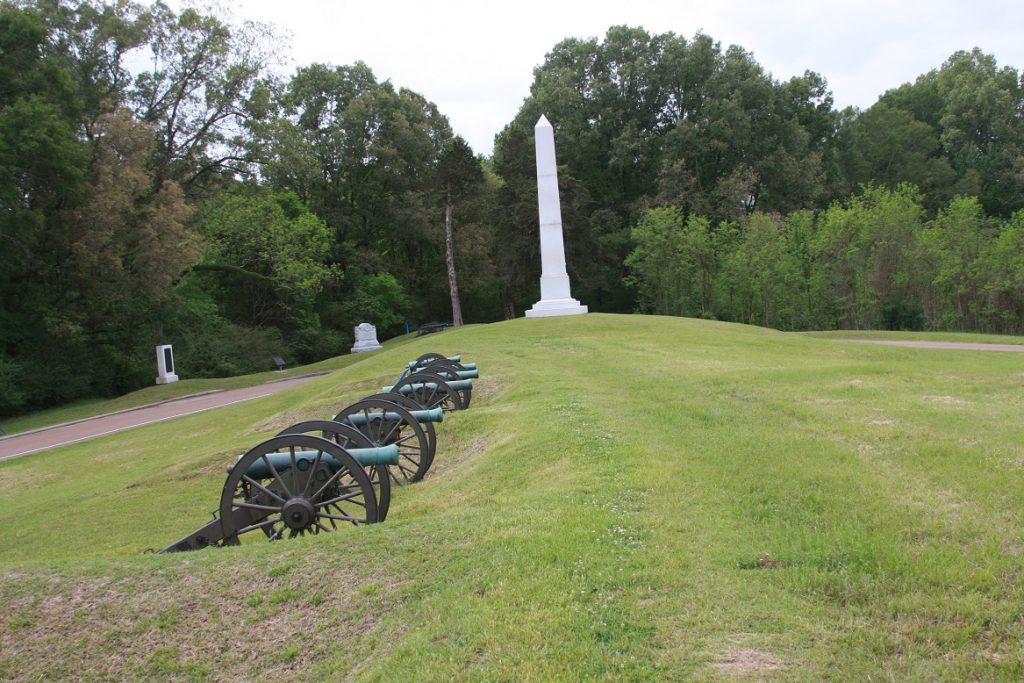April 15, 2023 @ 08:30 CDT
Site Visit #90
July 4, 1863 was a very bad day for the Confederacy in the U.S. Civil War. In the east, General Robert E. Lee’s Army of Virginia was heading back through Maryland to Virginia after their loss in the three-day battle at Gettysburg. In the west, General John Pemberton surrendered his troops that had held Vicksburg to Ulysses Grant on that day. Though brutal fighting continued for almost two more years, barring a major blunder by Union troops, the war was effectively won in those first four days of July.
One of the Union’s goals was to control the entire Mississippi River, effectively cutting off the western states of the Confederacy from the rest. Grant had been moving down the Mississippi from the north, while the Union Navy controlled much of the river south of Vicksburg, including control of New Orleans. By April 1863, they were ready to take Vicksburg.
Unfortunately, Vicksburg was not ready to be taken. The Confederate troops had built a formidable line of fortifications around the city and controlled the high bluffs overlooking the Mississippi River. Grant tried several attacks over the next month, but none succeeded in breaking the southern lines. He finally settled into a siege.

The Union troops remained active during the siege, subjecting the city and Confederate positions to constant artillery fire. Trenches and tunnels were dug to move troops closer to the southern lines. Meanwhile, food and supplies were running in short supply in the besieged city. The life expectancy of horses dropped significantly. Finally, realizing the alternative was starvation for not only his troops but the civilians of the city, Pemberton met with Grant and a surrender was arranged. Nearly 30,000 southern soldiers were captured and paroled.
Coupled with the news of Gettysburg, Lincoln was elated and presumed the war would soon end as Meade pursued Lee’s shattered army. But Meade did not pursue, allowing Lee to escape back into Virginia. Lincoln was furious and the war continued for two more years. Within a year, though, Ulysses Grant commanded all Union troops in the east.
Vicksburg National Military Park is one of the more popular Civil War sites, and unfortunately, my schedule had me arriving on a Saturday morning. The parking lot was already about half full and the visitor center buzzing with people looking through the gift shop and at the exhibits (mostly buzzing the gift shop for the standard touristy fare). As is my custom, I headed to the theater to watch the video about the battle before heading out on the self-guided auto tour route.
The route mostly follows the siege line, first following the Union lines, then returning along Confederate lines. The point where the road “crossed the lines” was at the USS Cairo Museum. This museum is dedicated to the ironclad riverboats used by the Union Navy during the campaign along the Mississippi. The USS Cairo was sunk after hitting a mine and its location was lost for almost 100 years. It has since been salvaged and its remains sit in front of the museum. There is a walkway that takes you inside the skeletal remains of the ship where the boilers and gears controlling the paddlewheel are still intact. The museum has many relics salvaged from the wreck and information on the entire fleet (all named for cities along rivers feeding the Mississippi).
Because so much of the battle occurred outside of the city and people recognized early on the need to protect it, much of the battleground has been preserved for us today. A National Cemetery is located inside of the park, originally holding Union soldiers killed during the battle. Confederates were buried in a separate, nearby cemetery.
The only downside to my visit was the overcast skies and threat of rain, not something I can blame on the Park Service. Fortunately, the rain held off until literally the moment I drove out of the park. It then rained almost non-stop for my four-hour drive to Mobile, Alabama!
Steve